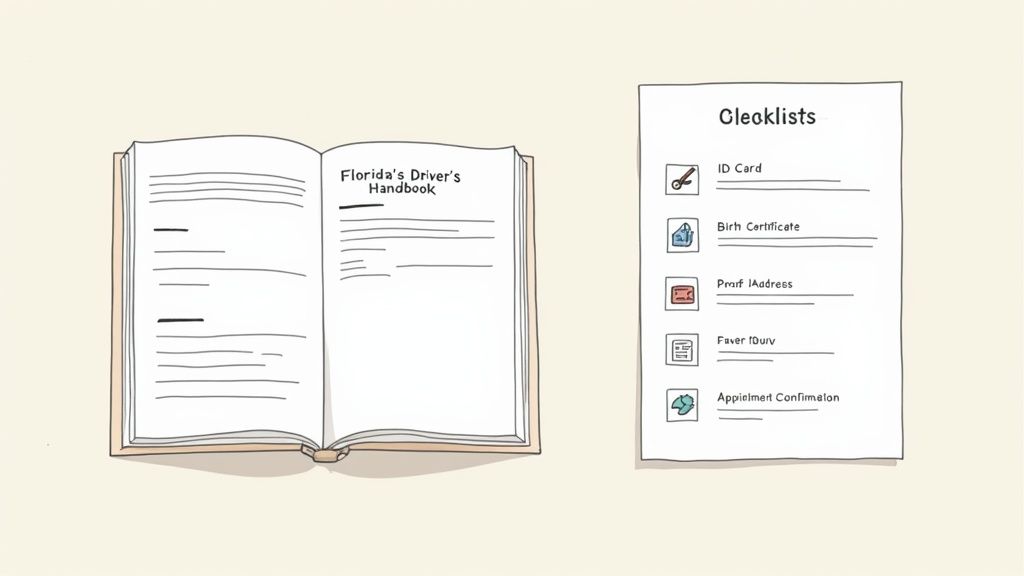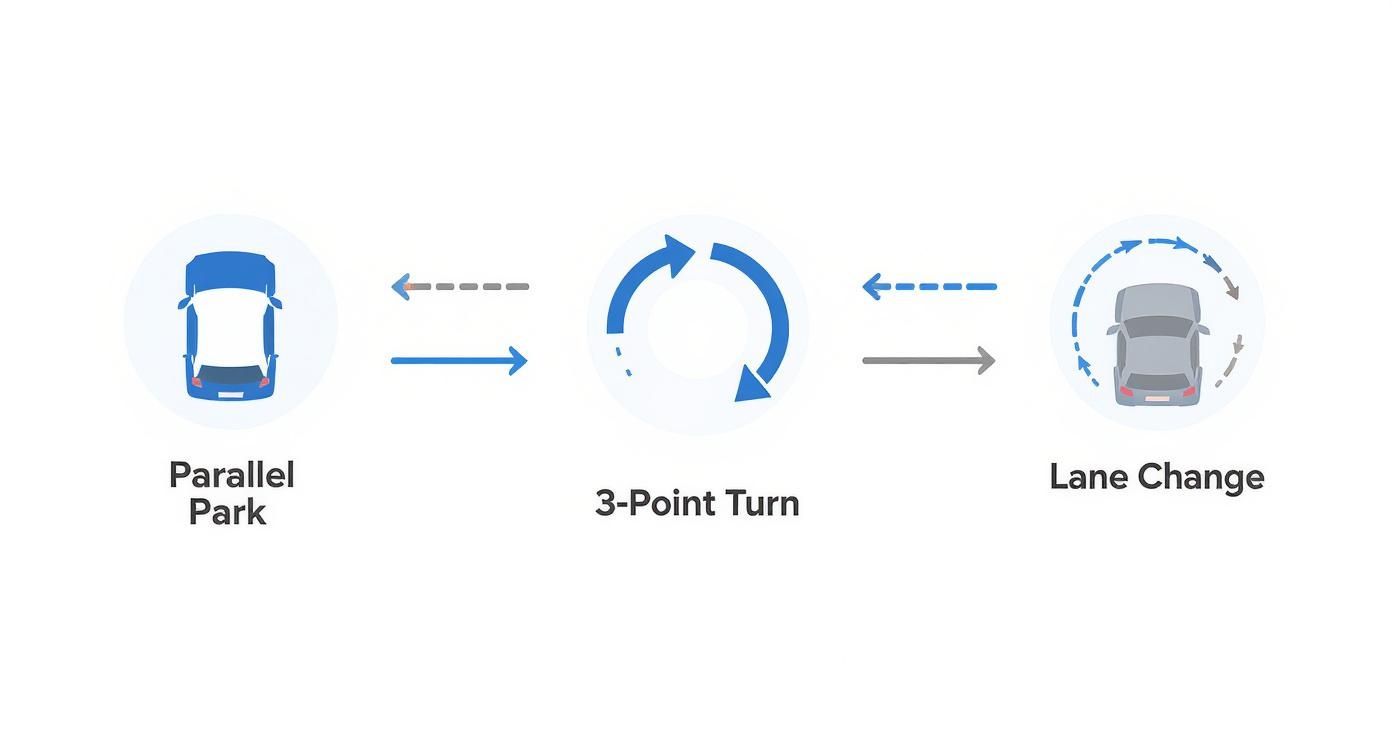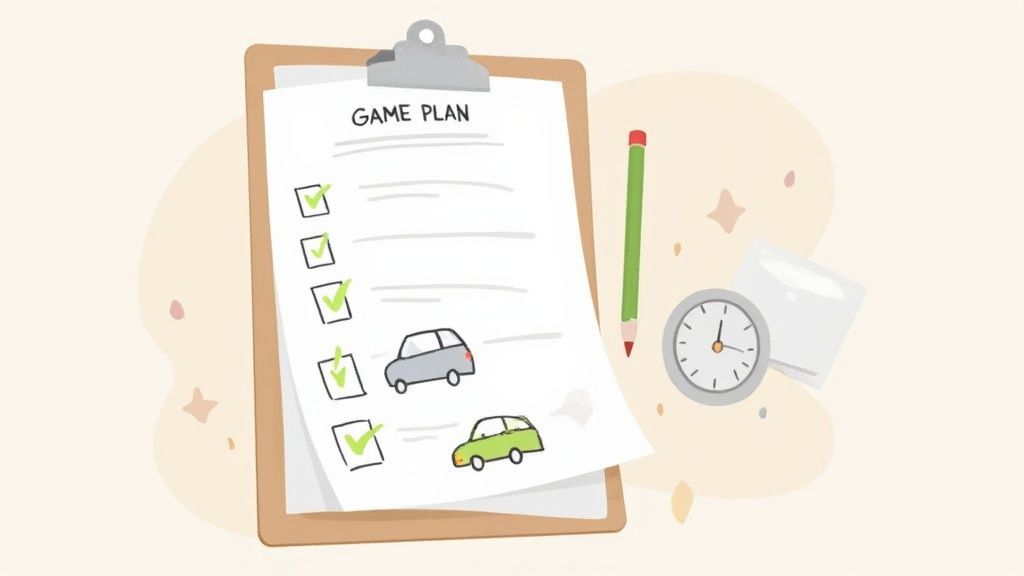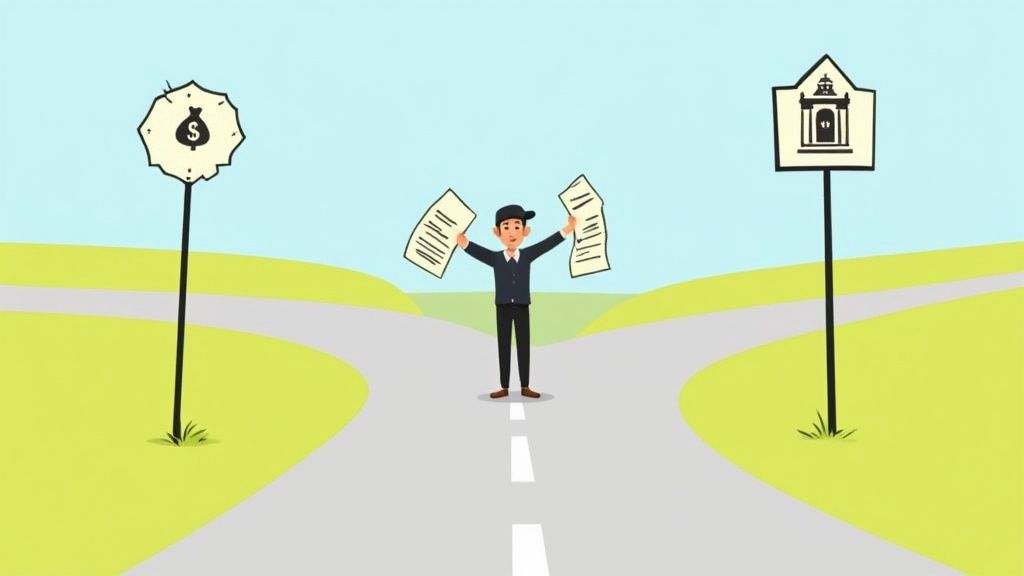Getting ready for your driving test starts way before you ever put the key in the ignition. The real prep work begins with building a solid base of knowledge and getting your paperwork in order. The key to passing is really knowing the official driver's handbook inside and out, not just cramming the night before.
Build Your Foundation Before Turning the Key

Genuine confidence on test day comes from a deep understanding of the rules of the road. Think of the Florida Driver’s Handbook as more than just a manual—it's your ultimate study guide. Your goal shouldn't be to just skim it, but to truly absorb the information so your actions behind the wheel become second nature.
This is a big deal because driving isn't the same everywhere. The World’s Best Drivers Index 2025 shows a huge difference in driving conditions globally. Countries with well-maintained roads and clear rules have much safer environments. But in places with poor infrastructure or heavy traffic, new drivers face a much steeper learning curve. Knowing the why behind Florida's rules gives you a major advantage.
Master the Theory Before You Drive
Before you start practicing three-point turns, take the time to nail down the theory. This knowledge is the foundation for every single skill you'll use on the road.
Make sure you really dig into these areas:
- Traffic Signs and Signals: Don't just memorize what a sign looks like. You need to know exactly what it's telling you to do, whether it's a yield sign at a busy roundabout or a speed limit sign in a school zone.
- Right-of-Way Rules: This is a common stumbling block for test-takers. Go over the rules for four-way stops, unmarked intersections, and highway merges until you're 100% sure who goes first in any scenario.
- Safe Driving Practices: The handbook is full of essential safety tips, from the three-to-four-second rule for following distance to how to drive safely in Florida's sudden downpours.
Think of it this way: learning the theory first is like learning the rules of a game before you step onto the field. It helps you anticipate what’s coming and react correctly, instead of just winging it. This is what separates a prepared driver from a nervous one.
Organize Your DMV Documents
Showing up to the DMV with a messy folder of papers is a surefire way to start your test day stressed out. Even a small paperwork mistake can get you sent home before you even see the car.
Gather everything you need well ahead of time. This simple step makes a world of difference, letting you walk in calm and ready to focus on what really matters—your driving. If you're looking for a structured way to learn, professional drivers education classes can really help lock in these fundamentals.
Mastering the Maneuvers That Matter Most
Putting in the hours behind the wheel is important, but it’s the quality of that practice time that really prepares you for test day. This is where you connect what you learned in the handbook to the real world, sharpening the exact skills the DMV examiner will be watching for. When you deliberately practice these key maneuvers, they become second nature—transforming abstract knowledge into pure muscle memory.
And let's be honest, passing the driving test isn't a given. Just look at the UK, where the Driver and Vehicle Standards Agency (DVSA) reported a practical test pass rate of just 48.9% in early 2025. Think about that: less than half of the people taking the test passed. This trend, which you can read more about in these test pass rate insights on rac.co.uk, shows just how critical solid preparation is. Those who take their practice seriously have a massive advantage.
Executing Flawless Three-Point Turns
Ah, the three-point turn. It's a classic maneuver designed to see how well you handle your car in a confined space.
The examiner isn't just watching to see if you can get the car turned around. They’re evaluating your spatial awareness, your smooth control of the wheel and pedals, and—most importantly—if you are constantly checking for traffic. A common slip-up is rushing through it or forgetting to scan in all directions before each movement. Find a quiet street and practice until it feels completely automatic.
Handling Smooth Lane Changes in Traffic
Safely changing lanes is a cornerstone of defensive driving, and your examiner will expect a clear, systematic process every single time. It’s not just about avoiding a crash; it’s about signaling your intentions to everyone else on the road.
This sequence needs to become a reflex:
- Signal First: Announce your intention long before you actually move.
- Check Mirrors: A quick glance in your rearview and side mirrors tells you what's happening around you.
- Check Your Blind Spot: This is the one people forget, and it's a huge deal. A quick look over your shoulder is non-negotiable.
- Move Smoothly: When it's clear, glide over. No sudden jerks.
- Cancel Signal: Once you’re settled in the new lane, turn your signal off.
Forgetting the blind spot check is one of the fastest ways to lose points on your test. Drill this sequence until you don’t even have to think about it. It shows the examiner you’re a genuinely aware driver.
Conquering the Dreaded Parallel Park
Let’s face it: for most new drivers, parallel parking is the most nerve-wracking part of the test. But I promise, it’s a skill you can absolutely master with a methodical approach and a lot of repetition. The trick is to stop seeing it as one giant, scary task and break it down into small, simple steps.
Start practicing in a low-stress area with cones or even just cardboard boxes to mark your spot. Get a feel for your reference points—like when to line up your side mirror with the other car's, exactly when to crank the wheel, and when to straighten out. Our guide on how to parallel park step-by-step breaks it down even further. Practice turns this intimidating maneuver into a controlled, confident skill.
Before you hit the road for your test, make sure you can confidently perform all the core maneuvers the examiner will be looking for. Use this checklist to track your progress and identify any skills that need a little more polish.
Essential Driving Maneuvers Checklist
| Maneuver | Key Focus Points | Common Mistakes to Avoid |
|---|---|---|
| Three-Point Turn | Constant traffic checks, smooth steering, minimal movements. | Forgetting to look over your shoulder, rushing the turn. |
| Lane Change | Signal, mirrors, blind spot check—every single time. | Not checking the blind spot, drifting too slowly or jerking. |
| Parallel Parking | Using reference points, controlling speed, finishing 12-18 inches from the curb. | Hitting the curb, parking too far away, poor angle. |
| Quick Stop | Stopping quickly and safely without locking the brakes. | Slamming on the brakes, losing control of the vehicle. |
| Backing Up Straight | Looking over your right shoulder, maintaining a straight line for 50 feet. | Relying only on mirrors, weaving from side to side. |
Going through this checklist won't just prepare you for the test; it will build the foundational skills that make you a safer, more competent driver for life.
Simulate the Real Test to Conquer Your Nerves
https://www.youtube.com/embed/MpxGxSoIbqw
Knowing how to drive is one thing, but proving you can do it flawlessly under pressure is a whole different ballgame. The best way I’ve found to get ready for the real deal is to take the surprise out of it. By running mock tests that feel just like the actual exam, you can turn a nerve-wracking ordeal into a familiar routine.
It all starts with mapping out your practice routes. Don't just stick to your own neighborhood. You need to spend serious time driving the streets around your local Florida DMV office. These are the exact roads your examiner will likely use for the test. Getting comfortable with their specific traffic patterns, intersections, and speed limits will give you a massive advantage.
Create a Realistic Test Environment
To really make these practice runs count, you have to make them feel authentic. This means asking your supervising driver—whether it’s a parent, older sibling, or friend—to play the part of the DMV examiner.
Here's how they can help you get in the zone:
- Keep it quiet. They should only speak to give clear, direct instructions, like “At the next intersection, turn left.” No small talk.
- Hold the feedback. Save all the tips and critiques for after the mock test is completely over.
- Use a scoresheet. Have them follow an official scoring sheet to track your performance, which makes the post-drive feedback specific and incredibly helpful.
This practice gets you used to the focused, quiet atmosphere of the actual test. Trust me, it can be unnerving if you’ve only ever practiced with someone chatting away next to you.
Test day jitters are almost always about the fear of the unknown. When you simulate the test, you’re not just practicing driving—you're practicing the test itself. That repetition is what builds real confidence and helps you keep a cool head when it matters most.
Zero In On the Tricky Stuff
As you’re out there practicing, make it a point to seek out the challenges you’re likely to face on the test. Try to think like an examiner. What situations would they use to test your awareness and vehicle control?
For example, deliberately drive through a school zone when the lights are flashing to practice your timing and adherence to the lower speed limit. Find a few tricky intersections with confusing signs or unprotected left turns and master them. Taking this kind of proactive approach means you’ll be ready for whatever they throw at you. If you need to brush up, you can get some free drivers training online to tackle specific scenarios before your mock tests.
This infographic breaks down the key maneuvers you'll want to have locked down during your practice sessions.

As you can see, mastering fundamentals like the three-point turn, lane changes, and parking is non-negotiable for passing your test.
Keep in mind that where you take your test matters. For example, pass rates in the UK can change dramatically from one test center to another. In 2024/2025, some of the toughest locations had pass rates as low as 33.4%, which is way below the national average of 48.9%. It just goes to show how much local road conditions can influence the outcome. That’s why practicing on the actual routes near your DMV is one of the smartest things you can do.
Your Test Day Game Plan for a Smooth Experience

All that time you've spent practicing on the road can be completely undermined by a chaotic test day. I've seen it happen. A driver who can perfectly execute a three-point turn during practice will fall apart because they forgot a piece of paperwork or showed up with a faulty brake light.
How you handle the final 24 hours is just as critical as the practice itself. Think of it as your pre-flight check. Getting organized the night before is the secret to walking into the DMV with calm confidence instead of frantic energy.
Your goal is to eliminate any surprises. This means gathering all your required documents—learner's permit, proof of insurance, and the vehicle's registration—and putting them in a single folder. Place that folder somewhere you absolutely cannot miss it, like right by your keys or on the front seat of the car.
The All-Important Vehicle Check
The first thing your driving examiner will do is inspect the car you brought. This isn't just a formality; if your vehicle fails this initial check, your test is over before it even starts. A cracked windshield, a burnt-out turn signal, or even a horn that doesn't work can lead to an automatic fail and a frustrating trip home.
Do yourself a huge favor and run through a quick inspection the evening before your appointment.
Before you take your vehicle to the test, you need to be certain it meets all the state's requirements. Here's a quick rundown of what the examiner will be looking for.
| Florida Driving Test Vehicle Requirements |
| :— | :— |
| Requirement Category | Specific Checks / Items Needed |
| Documentation | Valid Vehicle Registration, Proof of Insurance (current, not expired) |
| Safety Equipment | Functional Horn, Seatbelts for driver and examiner |
| Visibility | Windshield (no cracks), All mirrors intact, Working windshield wipers |
| Lighting | Headlights (low and high beams), Brake lights, Turn signals (front and back), Taillights |
| General Condition | Tires with adequate tread/pressure, Doors that open/close properly from inside and out |
This table covers the essentials that can get you sent home if they aren't in order. For a deeper dive, our guide on basic Florida vehicle maintenance has more tips to get your car test-ready. Spending five minutes on this check can save you a world of trouble.
Don't let a minor, fixable issue on your car be the reason you can't take your test. Walking through this quick inspection provides peace of mind and shows the examiner you’re a responsible vehicle operator from the very start.
Getting Your Head in the Game
Your mindset is just as crucial as your ability to parallel park. Test-day nerves are real, and they can absolutely sabotage your performance. The key is to manage them before they manage you.
Start the night before by getting a solid eight hours of sleep. Seriously. Avoid that late-night coffee or cram session—your brain needs rest to perform at its best.
On the morning of the test, eat a decent breakfast. Something balanced will give you sustained energy, unlike a sugary snack that can lead to a crash. Most importantly, plan to show up at the DMV at least 15-20 minutes before your scheduled time. This buffer is your secret weapon against stress. It gives you time to find a parking spot, take a deep breath, and walk in without feeling rushed. A calm arrival sets the stage for a calm and successful test.
How to Impress Your Driving Examiner

Look, getting your license isn't just about nailing a three-point turn. The driving test is really about showing the examiner you're a safe, aware, and responsible driver who can handle the realities of the road. They're not looking for perfection; they’re looking for competence and confidence.
Think of it this way: your actions are constantly communicating with the examiner. You need to make sure they're getting the right message. When you check your mirrors or glance over your shoulder for a blind spot, don't just flick your eyes. Make a deliberate, obvious head turn. Leave no doubt in their mind that you are performing every necessary safety check.
Communicating Confidence Through Action
How you carry yourself in the car speaks volumes. A calm, focused attitude from the get-go tells the examiner you're taking this seriously.
Before you even turn the key, get settled. Adjust your seat, tweak your mirrors, and fasten your seatbelt. These small, methodical steps show you’re prepared and safety-conscious. Listen intently to their instructions. If you don’t quite catch something, don't just guess—ask for clarification. It's much better than making a critical error because you misheard.
Imagine an ambulance is approaching with its sirens on. This is a classic test-day scenario. A prepared driver will:
- Stay calm and quickly pinpoint where the emergency vehicle is coming from.
- Signal their intent to move.
- Pull over to the right smoothly and safely come to a stop.
- Wait for it to pass, then carefully check mirrors and traffic before merging back onto the road.
Handling a moment like that with a cool head is exactly what they want to see. It proves you can manage unexpected situations without panicking.
The driving test isn't about being a flawless driver—no one is. Examiners know you're new to this. What they truly care about is your ability to operate the vehicle safely and recover calmly from small mistakes.
Handling Mistakes and Unexpected Events
So, you took a turn a bit too wide or braked a little abruptly. It’s not the end of the world. The most important thing is how you react after the mistake. Don't get flustered, and definitely don't make excuses. Just take a quiet, deep breath, acknowledge it to yourself, and refocus on the road ahead.
Your reaction to other drivers is just as telling. If someone cuts you off, the examiner is watching. They want to see you create space and maintain safety, not get angry. This is defensive driving in action, and it’s a massive plus in their book. By showing you can handle real-world scenarios gracefully, you're proving you're more than ready to have that license in your wallet.
Common Questions About the Driving Test
Even after you've logged plenty of hours behind the wheel, a few questions always seem to pop up as test day gets closer. That's perfectly normal. Getting these last-minute uncertainties cleared up can make all the difference, helping you walk into the DMV feeling relaxed and ready to go.
What Are the Most Common Reasons People Fail?
You'd be surprised how often simple, fundamental errors are what trip people up on the Florida driving test. The infamous "rolling stop" is a classic example—if your car doesn't come to a full and complete stop, it's a major red flag for the examiner.
Another big one? Forgetting to check blind spots. This is a non-negotiable safety check every single time you change lanes or merge.
Other common mistakes that can lead to a fail include:
- Poor Lane Position: Hugging one side of the lane too closely or drifting over the center line shows a lack of control.
- A Fumbled Three-Point Turn: This maneuver needs to be done smoothly and safely, without hitting the curb or taking too many adjustments.
- Examiner Intervention: This is the big one. If you do anything that forces the examiner to give you a verbal warning or physically take control of the car, it's an automatic fail.
The bottom line is that examiners are looking for one thing above all else: safety. If you can prove you're a safe, responsible driver by mastering these core skills, you'll avoid the common pitfalls.
Can I Use My Own Car for the Driving Test?
Absolutely! In fact, it's usually the best way to go. Taking the test in a car you already know inside and out can be a huge confidence booster and help calm your nerves.
There's a catch, though. Your car has to meet the state's requirements. You'll need to bring physical proof of the vehicle's current registration and insurance. Before you even start the engine, the examiner will do a quick safety inspection. They’ll check your headlights, brake lights, turn signals, and horn to make sure everything works. If any of these are out, your test is over before it begins.
What Happens If I Make a Small Mistake?
Don't panic! A minor slip-up doesn't automatically mean you've failed. The examiners know you're not a professional driver yet; they’re looking at your overall competence, not perfection.
The test is scored on points, and a small error, like taking a turn a bit too wide, will likely just be a small point deduction. What really matters is how you react. The best thing you can do is stay calm, correct the mistake safely, and move on. Getting flustered and making another bad move is what can turn a tiny error into a failing grade.
At BDISchool, we know that solid preparation builds the confidence you need to succeed. Our state-approved courses are designed to get you ready not just for the test, but for a lifetime of safe driving. Find out more at https://bdischool.com.





